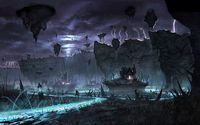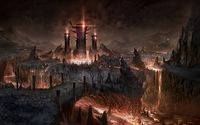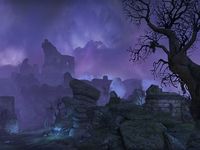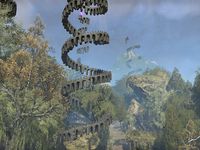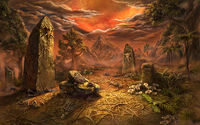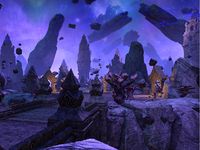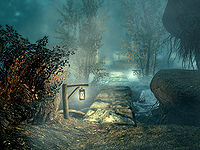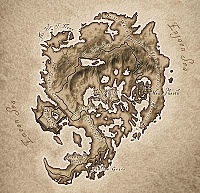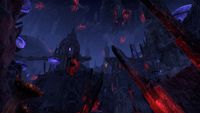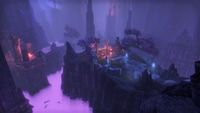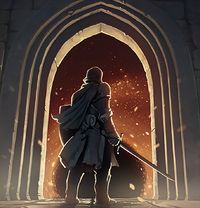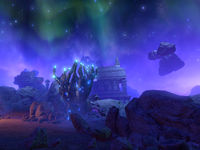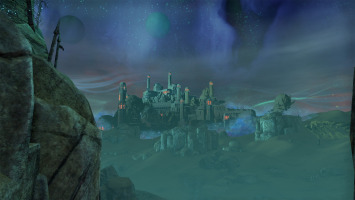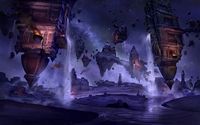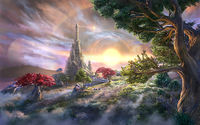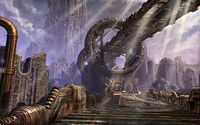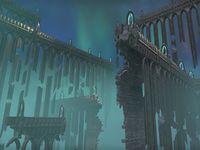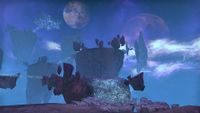Lore:Planes of Existence
Contents
- 1 Daedric Princes' Realms
- 2 Other Realms of Oblivion
- 2.1 Abyss
- 2.2 Arum-Khal's Realm
- 2.3 Chimera of Desolation
- 2.4 Deadlight
- 2.5 Desolation's End
- 2.6 Detritus
- 2.7 Dyzera's Realm
- 2.8 Fargrave
- 2.9 Fourth Sinus of Takubar
- 2.10 Gaiar Alata
- 2.11 Grayhaven
- 2.12 Havoc Wellhead
- 2.13 Gorge
- 2.14 Infernace
- 2.15 Levinace
- 2.16 Desolation's End
- 2.17 Maelstrom
- 2.18 Nightflame
- 2.19 Noweyr
- 2.20 Prison of Xykenaz
- 2.21 Realm of the Hist
- 2.22 Sadal's Prison
- 2.23 Shalidor's Shrouded Realm
- 2.24 Soul Cairn
- 2.25 Umbriel
- 2.26 Village of the Lost
- 3 Realms of Aetherius
- 4 Realms of Mundus
- 5 Parallel Realms
- 6 Other Realms
- 7 See Also
- 8 References
Within the Aurbis exist a multitude of different planes of existence, from the well-known mortal realm of Mundus and the planes of the Daedric Princes, to the mysterious Oblivion pocket realms and the magical planes of Aetherius. The term Outer Realms usually refers to Aetherius and Oblivion together,[1] but may also include a number of "other, less structured forms" in the Aurbis.[2] It is said that there also exist planes beyond Aetherius, and harder to travel to than it, where even powerful magic such as that of the Sea Sload can't reach, and the location of which is unknown to even the Daedric Princes.[3] The plane to which the Psijic Order transport their island of Artaeum when it is not on Nirn is said to be one such realm.[4][5][6] The very "sinews" and "viscera" of the planes are said to be comprised of magicka, the strings of magic holding the realms and threading all existence together.[7][8]
Several terms may be used to classify realms. Slipstream Realms are points within the Aurbis at which transliminal forces balance. They operate as transition zones where the conceptual truths of different realms can coexist.[9] Oblivious Vortexes are realms between planes that gather drifting fragments of chaotic creatia.[10] Inchoate Realms are regions of incomplete and half-finished demi-planes that were for some reason abandoned by their projectors. They are highly unstable and prone to volatile realm-rips. Collective Realms are planes that exist as collective extensions of their numerous, less-powerful inhabitants. Sundered Realms are pocket realities that were shattered by interplanar war or Princely expungement.[9] Adjacent Places exist past the normal non-cardinal points[11] and exist as parallel reflections of the realms they are 'adjacent' of.[UOL 1]
Pocket Realms (alternatively Pocket Realities,[9] Pocket Planes,[12] or Pocket Dimensions[13]) are self-contained realities exempt from the laws of nature, often lying beyond mortal comprehension.[14] There are a nearly infinite number of them, located between planes in gathered chaotic creatia.[9][10] Stretches of Oblivion such as the Ur-Mora Clarion region contain tens of thousands.[9] They are typically smaller and weaker than typical planes, prone to collapsing at significant magical disruption.[12] Despite this, some Pocket Realms have been described as having more extensive or even infinite scale, and not conforming to the rules of reality mortals know.[15][16][17]. Pocket realms are defined by their minor nature in comparison to the greater planes, and are often under the jurisdiction of a Daedric Prince, though they might not lie within the same time and space as that Prince's main realm.[18][19][17] Some pocket realms are only accessible from Nirn.[20]
Pocket Realms can also be pieces of a greater plane.[21][17] These are also referred to as Subrealms or Adjunct Realms, referring to their connection to a greater plane.[19] Other planar designations exist, such as Nanoplanes[22] and Demiplanes,[23] but their exact parameters are unclear. The designation Chaos Realms seems to refer both to the sixteen Planes of Oblivion[24] and a type of minor reality similar to pocket realms.[25]
The realms comprising Oblivion are described as being part of a different universe or a different dimension in relation to Mundus.[26] Oblivion realms are an extension of their masters, maintained either by greater Daedra or the collective will of many lesser Daedra, although some are ruled by mortals who have ascended to immortality—like the Ideal Masters.[27][UOL 2] Accounts from the Daedra describe the minor realms in Oblivion as overall being infinite in both number and complexity.[28] It is said that Oblivion realms can be infinite in both size and shape, and that all proper Oblivion realms are infinite in scale.[17][UOL 3] The realms of Oblivion have been described as "infinite in their variation", just like the Daedra that inhabit them, thus it is said they share little in common, being "the very definition of change and variation, manifesting all possibilities, and validating all understanding and misunderstanding".[29][30] Indeed, it is said that what the mortal senses perceive while in an Oblivion realm is crafted from illusion and metaphor, the result of their mind attempting to make sense of the surrounding chaos. Because of this phenomenon things like the "grass" one might perceive while in an Oblivion realm, are actually just the memory of that thing as interpreted by the mortal mind.[31]
The planes of Aurbis are made up of different reality layers, spatially overlapping sections which can be accessed via the use of magic which shifts beings and objects between them, things shifted to a different layer generally can't be perceived or interacted with by those who lack the necessary arcane means.[32][33][34][35]
Beyond and outside the Aurbis and all it's constituent planes exist the Many Paths.[36][17]
Daedric Princes' Realms[edit]
Oblivion contains all the dimensional planes which are home to the Daedra. The sixteen realms of the Daedric Princes, referred to by the general term Planes of Oblivion, can be very extensive, Molag Bal's plane is described as being an apocalyptic replica of all of Nirn, and Hermaeus Mora's is said to be infinite in size. Indeed, according to Sotha Sil, were a Prince to simultaneously invade the realms of the other Princes to seize the power within through the use of something like the Crystal Tower, they'd gain infinite power through the infinite connections made.[37] It has been said that, just like Apocrypha, all proper Oblivion realms are infinite in size.[17]
Each prince's plane may have a more specific name, such as Apocrypha for Hermaeus Mora's, Coldharbour for Molag Bal's, Moonshadow for Azura's, and Quagmire for Vaermina's. Each plane is supposedly very different in appearance, depending upon the nature of the prince who rules it, as the realms of the Princes are extensions of those Princes.[UOL 2][38] They can range from beautiful to desolate; some may not even resemble worlds as we think of them, containing nothing but dust and smoke, or changing constantly.
Apocrypha[edit]
Apocrypha is a realm of Oblivion created and ruled over by Hermaeus Mora, the Daedric Prince of Knowledge and Fate. The geography of the realm varies, with some areas being open with fields containing odd flora, other areas are an endless library consisting of untitled books with black covers, where all forbidden knowledge can be found, and the crackling towers of learning mingle with archways of despair and confusion. The realm is haunted by the ghosts of mortals forever searching for knowledge. Stacks of books form mazes and spiraling pillars that can reach as high as the illuminating green sky. Intricate ruins and monstrous carvings can be found among the stacks. The plane is covered in a sea of ink and roiling tentacles, while Hermaeus Mora is omnipresent over all, taking glee in tormenting mortals from his realm. Some areas of the realm are consumed by darkness which can kill any who enter it. Discarded pages and floating tomes fill the fetid air, as if pulled by invisible string. Storms of notorious strength purportedly rage over Apocrypha.
Apart from magical teleportation, Apocrypha is most easily entered by mortals through the reading of Black Books, tomes of forbidden knowledge displaced from time and scattered across Tamriel. An apparition of the reader's body remains in Mundus, tethering their life force. Most mortals who gain access to the secrets within Apocrypha are driven insane by unending revelations. Such was the fate of the mage Morian Zenas, who famously disappeared in Apocrypha during his voyages through Oblivion. However, those who successfully journey through Apocrypha are known to discover powerful knowledge. The laws of the mortal world hold no power in this realm.
Ashpit[edit]
Ashpit is a realm of Oblivion ruled over by Malacath, the Daedric Prince of Outcasts. The exact manner and time in which the realm came to be, and whether and how it might be tied to the commonly believed transformation of Trinimac into Malacath, are not known. Orcish spellwrights call for boons from the Ashpit and rarely any other realms. That includes conjuring Flame Atronachs. The Ashpit is hard to access, as the pathways to his domain take on a characteristic level of concealment to protect the disenfranchised and cast-out.
The realm mostly consists only of dust, palaces of smoke, and vaporous creatures; anguish, betrayal, and broken promises like ash fill the bitter air. Few mortals manage to reach the realm, where levitation and magical breathing are necessary to survive. The Mages Guild have been known to bottle the realm's thick, roiling vapor.
The Spine of Ashpit is a surprisingly light skeletal spine found in the realm. It is made from a grey dust, and fragments of bone have been known to be taken from it and brought to Tamriel. Sheogorath claims that the spine is the metaphorical "backbone" of the realm, which he looks down upon.
However, some areas of the realm are safe for mortals. In 4E 48, Malacath chose to bring Sul and Prince Attrebus Mede to the Ashpit, where they found a garden of slender trees, and "vines festooned with lilylike flowers" wound about the trunks; a "multitude of spheres moved, deep in the colorless sky, as distant and pale as moons". Occasionally the vines "collapsed and formed into a cloud of black moths that swarmed about them". This garden seems to have some emotional significance to Malacath, who describes it as a "shadow of a garden", and an "echo of something that once was".
The Ashen Forge sits at the center of Malacath's own stronghold in the Ashpit. For the Orcs that revere Malacath, the afterlife promises rewards of immortality, abundant food and drink, and constant battle deep within the Ashen Forge. It is also said that, as the ultimate expression of the Orc stronghold, the Ashpit bastion stretches endlessly across the planes, extending even behind the stars to Aetherius, granting access to every worthy Orc who crosses from this life into the next. In Malacath's stronghold, every Orc is a chief, every chief has a thousand wives, and every wife has a thousand slaves to cater to their every need. The stronghold's walls rise one hundred feet into the smoky sky, constructed of polished steel and worked iron. Inside the walls, stone keeps, iron towers, and massive longhouses surround the central square that houses the Ashen Forge.
The endless space within Malacath's smithy is filled by the Ashen Forge, a massive hearth which burns with a fire hotter than the Sun, said to be kept alive by the adherence of the Orcs to the Code of Malacath. The heat powering the forge comes from white hot coals said to be the very manifestation of the Code of Malacath, it is described as a flame of emptiness, betrayal, and broken promises, which imbues each newly forged orc with a foundation of resentment that will take them far in the mortal world.
[edit]
Attribution's Share is the plane of Oblivion created and ruled over by Boethiah, the Daedric Prince of Deceit. The Realm of Boethia is described as a country of labyrinthine policy and betrayals, with maze gardens and twisted towers. It was formerly known as Snake Mount.
Coldharbour[edit]
Coldharbour is a realm of Oblivion created and ruled over by Molag Bal, the Daedric Prince of Domination. As befits his sphere, Bal's realm is a desolate, apocalyptic image of Nirn, which is achieved by both mocking imitation and outright theft of parts of the mortal realm. It is inhabited by Daedra and the eternally-tormented husks of mortals called Soul Shriven.
Mortals who made deals with Molag Bal can also be found living in Coldharbour. The souls of vampires are sent to Coldharbour when they die. Coldharbour has been described as a manifestation of fear and exploitation. Descriptions of the plane vary widely, but all accounts agree that Coldharbour is a dismal, cold, and largely lifeless realm.
Colored Rooms[edit]
The Colored Rooms are a many-faceted realm of Oblivion, created and ruled over by Meridia, known as the Daedric Prince of Infinite Energies. From what little has been seen of the Colored Rooms, they seem to resemble a cross between a coral reef and a vast field of floating stones, strewn with colorful trails of dust or cloud. The "ground" between the stones looks like luminescent water, but is solid enough to walk on. The skies are described as floating effluvium oceans of crimson. It has been suggested that the "colors" of the realms are a reference to the different schools of magic.
Aurorans and their warhorses are the spawn of Meridia that reside in the Colored Rooms, being made from pure light and have skin tones of virtually any hue. Golden Saints are also purported to reside in the realm. The Colored Rooms have been described by those souls who have been there as "pretty boring" aside from Meridia's lectures (which are described as "pretty boring" as well).
Deadlands[edit]
The Deadlands are a Daedric realm of Oblivion created and ruled over by the Daedric Prince of Destruction, Mehrunes Dagon. The embodiment of its creator's sphere, the dimension is fraught with natural disasters and destructive change. The area known as the Burn is covered by an ocean of lava, scattered with scorched volcanic islands and ruined structures. Many lesser Daedra roam the realm freely, but Dremora dominate the hierarchy. The Sever is a region of the Deadlands with light soil covering jagged rock with sulfur pools throughout, fierce winds, and constant lightning storms. Destructive tornadoes and extremes in temperature characterize the region. The capital of the Deadlands is known as Destruction's Solace.
The force of Change, one of the Eleven Forces, flows strongly in the Deadlands, as all aspects of Dagon's sphere are rooted in Change. The currents flow so strongly that one who attempts to tap into change within the realm runs the risk of being swept away, and entering a synchroseiseiac state, becoming out of sync with reality and being scattered across time and space. Thus the realm is especially suited for those wishing to study that force. Some Daedra that reside in the Deadlands have thus learned how to read the flow of Change, granting them such clarity they're practically precognitive.
Evergloam[edit]
The Evergloam is a realm of Oblivion, created and ruled over by Nocturnal, the Daedric Prince of Shadow. It is a realm of perpetual twilight, and the "cradle of shadow". The Evergloam exists adjacent to all other realms of reality simultaneously, it can almost be glimpsed when one turns and looks quickly while in the dark. It consists of a primary plane and several pocket realms, including the Shade Perilous and the Crow's Wood. These realms are thought to be constantly shifting, and are perceived differently by different mortals. It is filled with forests, whose trees cast long shadows over a purple landscape. The land is dotted with crumbling buildings and sunken crypts.
Fields of Regret[edit]
The Fields of Regret are a realm of Oblivion, created and ruled over by Clavicus Vile, the Daedric Prince of Wishes. The realm appears as a tranquil countryside, dotted with majestic cities of glass and ornate buildings and populated by Skaafin. It contains dense forests, lakes, and mountains, with floating golden metals and stone spirals filling the landscape. The city of Umbriel was once a part of the realm, but was eventually severed and came to rest in the Realm of the Hist.
According to some sources, the Fields of Regret are not a place in the same sense that a place on Nirn is, rather the realm is a "state of mind", specifically the state of mind of Clavicus Vile, which reflects on the realm and causes everything there to be exactly as Vile wishes it to be. Thus its form is said to represent Vile's mindset, a green, sunny and pleasant land interspersed with tranquil ponds under an expanse of clear blue sky, reflecting Vile's view of himself as a playful and fun-loving god who basks alongside his companion, Barbas, the pleasant appearance concealing Vile's true temperament which is likened to that of a child cruelly playing with insects.
Hunting Grounds[edit]
The Hunting Grounds, also known as the Great Hunt, is a realm of Oblivion created and ruled over by Hircine, the Daedric Prince of the Hunt. It has been described as a realm of dense woodland and vast grasslands populated by werebears, wild cattle and unicorns. It is a savage land inhabited by vicious creatures such as bears, wolves, werecreatures, and Daedra. These creatures are generally much larger than their counterparts in the mortal realm. The spirits of animals from the mortal plane are a common sight within the Hunting Grounds, as Hircine brings them in to please his followers. All who die within the Hunting Grounds are doomed to remain within the realm after death. Inhabitants of the realm may take on the shapes of various animals to participate in the eternal hunt.
Followers of Hircine are promised an afterlife within the Hunting Grounds, where they can indulge in spectacular hunts, as well as experience an endless cycle of violence as well as death and rebirth, reborn endlessly in bodies that never fall ill. Its inhabitants reside in the many hunting lodges dotting the landscape. The forests of the Hunting Grounds are teeming with powerful beasts, which allow Hircine's followers to engage in the most spectacular hunts. For the devoted, it is a paradise. The souls of lycanthropes are claimed by Hircine and spend eternity experiencing the thrill of the hunt in his Hunting Grounds. However, it is possible for a soul to transfer to the proper afterlife (such as Sovngarde) if their lycanthropy is cured posthumously, provided their soul is yet to have been taken to the Hunting Grounds. During the daylight hours, werebears and fierce Nords stalk the land in their continual Hunt. When the sun sinks below the horizon, Hircine announces himself with a pack of werewolves to take his turn in the cycle.
Mirrormoor[edit]
Mirrormoor was the realm of the Daedric Prince Ithelia, Mistress of the Untraveled Road. Fargrave is a fragment of this forgotten realm.
Mirromoor is a large desert wasteland filled with gargantuan skeletons and surrounded by an auroral sky. While Ithelia is active, it is filled by shattered mirrors and crystalline structures and the sky is fractured by cracks. Those elements were not present in Fargrave before Ithelia's return.
Moonshadow[edit]
Moonshadow is a realm of Oblivion created and ruled over by the Daedric Prince Azura, Queen of Dawn and Dusk. The realm is said to hold "too much beauty", so much so it can render mortal visitors "half-blind". It contains flowers, waterfalls, pink trees, and a city of silver. Azura herself resides in a rose palace, and is welcoming to mortal travelers.
To the Khajiit, Moonshadow is where Azurah tends the Gates of the Crossing—the bridge between Nirni and the afterlife beyond. It is there where they are guided to the Sands Behind the Stars if they are worthy.
According to myth, as Azurah wept in the Great Darkness after the death of her mother, the light from her tears chased away the Darkness and eventually left a "place of moonlight and shadow". Khajiiti mythology also writes that when Magrus fled from Boethra and Lorkhaj after the former had plucked his eye out, he fell into the Moonshadow. There, Azurah judged him as too fearful to rule a sphere, and tore out his other eye. The blinded Magrus fled to the heavens, and Azurah made of his eye a "stone to reflect the Varliance Gate".
Scuttling Void[edit]
The Scuttling Void is a realm of Oblivion ruled over by the Daedric Prince Namira. The Khajiit call it the Dark Behind the World (which is sometimes shortened to the Dark), or Namiira's Void. When a particularly large rift opens between the Dark Behind the World and Nirni, the breach is referred to as a Maw of Lorkhaj. Very little is known of this shadowy Daedra's realm.
Pits[edit]
The Pits is a realm of Oblivion, created and ruled over by Peryite, the Daedric Prince of Pestilence. Here, Peryite guards the lowest orders of Oblivion.
It is unknown what the realm looks like overall. What little that has been seen of the realm resembles the Deadlands, with lava seas, volcanic islands and ruined structures. The realm is usually completely inaccessible to mortals, but there have been several exceptions.
Revelry[edit]
The Myriad Realms of Revelry, also called the Realms of Revelry or Revelry for short, are a congeries of one hundred thousand pocket and sub-realms of Oblivion, created and ruled over by the Daedric Prince of Indulgence, Sanguine. The realms are used mainly as pleasure pockets, refashioned to meet the needs and desires of its visitants. As such, Sanguine exerts minimal control over them, which aligns perfectly with his preferences.
The waters found within the Realms of Revelry were documented in Sanguine's Rites and Realms by the Prisoner of the Evergloam. This text documented a phenomenon in which visions of ill-fated, prince-less realms of Oblivion colliding with each other could be seen within the waters' reflections.
Shivering Isles[edit]
- For more information, see the articles on Shivering Isles and Jyggalag's Realm.
The Shivering Isles, also called the Realm of Madness, the Madhouse, or the Asylums, is the Daedric realm of Sheogorath, Prince of Madness. The realm consists of a main landmass surrounded by a group of smaller islands, the area of which is divided in half: the northern half of these lands is called Mania, and the southern half Dementia. This divide represents Sheogorath's split personality, the "two shades of madness". The isles are inhabited by mortals as well as Daedra, but they have been driven insane.
Spiral Skein[edit]
The Spiral Skein is the realm of Oblivion created and ruled over by Mephala, the Daedric Prince of Lies. Some portions of the realm resemble a dark, sprawling cavern with a high ceiling, dotted with luminescent mushrooms. Spiders, hoarvors and all manner of crawling creature inhabit the plane, and tall buildings with arches and spires dot the landscape. Crystals of deep red hues jut from the cliffs, ceilings and walls in geometric clusters comprised of prism-like shapes.
Quagmire[edit]
Quagmire, or the Dreamstride, is a realm of Oblivion, created and ruled over by the Daedric Prince of Nightmare, Vaermina. It is a realm of horrors, where reality shifts upon itself in seemingly impossible ways. Every few minutes, lightning flashes and the realm morphs into a terrifying scene, each one more frightening than the last. Mortal sleepers often slip into this realm without any help at all.
From her citadel in the center of the realm, Vaermina reaches out into Mundus and collects the memories of sleeping mortals, leaving nothing but visions of horror and despair. These experiences, known as nightmares, involve the mind of a mortal traveling to Quagmire. Through magical teleportation, it is possible for a mortal to enter Quagmire while awake, as was done by the mage Morian Zenas. It is inhabited by Omens, daedric servants of Vaermina, who sends them to haunt the inhabitants of Nirn.
Other Realms of Oblivion[edit]
There are over 37,000 pocket realms of Oblivion with drastically varying purposes. Some are created by Daedric Princes as a prison or purgatory, while others are the homes of certain lesser Daedra.
Abyss[edit]
The Abyss is a mysterious realm of Oblivion consisting of a never-ending series of rooms and corridors, both real and unreal at the same time, which together form an endless dungeon. Few have survived exploring the infinite reaches of the Abyss, and none have conquered it. It is said to be linked to the Ayleid lich king, Celemaril Light-Bringer. However, Celemaril is not responsible for its creation.
Arum-Khal's Realm[edit]
Arum-Khal's Realm was a dark plane of existence created by the dro-m'Athra lich Arum-Khal where only dark spirits could thrive. It resembled floating islands with glowing corals and ruined Khajiiti architecture hanging in a void of eternal twilight, reminiscent to that of the Dark Behind the World. It was destroyed circa 2E 582.
Chimera of Desolation[edit]
The Chimera of Desolation is a small realm of Oblivion created by the Daedric Prince Mehrunes Dagon.
The Chimera was once Caecilly Island, a small island off the coast of Northmoor (or Glenumbra, according to some sources) in High Rock. The entire island was cast into the void during the Third Era as an act of revenge against Chimere Graegyn, a mortal conjurer living there. The abandoned towns of Trybador and Granvellusa still stand on the desolate island.
The plane was once accessible via the Battlespire, but this link was severed following Dagon's invasion of the edifice during the Imperial Simulacrum. Upon Dagon's banishment during the Oblivion Crisis, Caecilly was returned back to Tamriel.
Deadlight[edit]
Deadlight is a shattered plane of Oblivion, said to have been destroyed in the ancient past by Mehrunes Dagon.
According to legend, the realm was once the domain of a forgotten Daedric Prince who earned Dagon's wrath. In response, Dagon made war upon the Prince, destroying his home. Nothing remained of his realm but a shattered fragment, a place illuminated only by a green, ghostly aurora. The realm possess a ruined keep, which stood beneath a starless sky. The plane itself is devoid of life and energy, which is unusual for a realm of Oblivion. The surrounding landscape consists of jagged stone peaks, dotted with lightning rods and flora typical of the Deadlands such as bloodgrass.
The only known entrance to Deadlight is a crumbling portal dais called the Western Gate, located in a region of the Deadlands known as the Burn.
Desolation's End[edit]
Desolation's End was a small pocket realm of Oblivion, created in 2E 582 by a member of the Bloodthorn Cult called Lord Velian.
It was created through necromantic ritual after the villagers of Eagle's Brook, in the Cambray Hills region of High Rock, were turned into zombies. The realm resembled a nightmarish Daedric ruin covered in glowing red glyphs and surrounded by lava. The ruin's only inhabitants were banekin and Velian's shade.
The local mage, Merien Sellan, learned of Velian's ritual and entered the pocket realm to stop him. He allowed himself to be willingly captured in order to collapse the plane, killing himself in the process. His son Tamien asked the Vestige to enter the realm and kill Velian, allowing Merien to escape before the collapse but also allowing the cultists to leave with the zombie army by ship. It is unknown if Merien was rescued, although the realm was collapsed regardless.
Detritus[edit]
Detritus is a ghastly demi-plane of Oblivion ruled over by Hollowjack, the Lord of Mortal Fears. It has also been described as a "half-world", and is a realm filled with untold horrors. Every year, during the Witches Festival on the 13th of Frost Fall, the portals between Nirn and Detritus open and gruesome items from this realm flood the markets of Tamriel. According to an enigmatic and immortal entity known as the Impresario, Detritus is a "carving" from the shell of Hircine's Hunting Grounds.
Hollowjack derives his supernatural power from metaphysically feeding on the fear of mortals, and his realm is dedicated to this singular purpose. Detritus is described as a claustrophobic series of small spaces cluttered and jammed with piles of mortals' lost and broken personal items. Hollowjack frivols there among his collection of shattered memories, categorizing and classing and replaying them to find new vulnerabilities in the mortal mind. There is no outside on Detritus, only room after room of recurring nightmares and internal torments. According to Hollowjack, this is because "mortals fear most what is inside themselves".
Dyzera's Realm[edit]
Dyzera's Realm is a small pocket realm of Oblivion ruled over by a powerful Nocturnal Shrike named Dyzera, a servant of the Daedric Prince Nocturnal. It is a realm of perpetual twilight resembling the Evergloam, covered by exotic bioluminescent plant life.
Fargrave[edit]
Fargrave, also known as the Celestial Palanquin, is an obscure demiplane of Oblivion, functioning as a crossroads where the paths through Oblivion become easier to navigate. With no prince to rule, the accords that make it harder for other realms to connect to Nirn do not apply, making it a convenient way station between Nirn and the rest of Oblivion. In appearance, it is a large desert wasteland filled with gargantuan skeletons and surrounded by an auroral sky.
Daedra and mortals alike can be found here, engaging in trade on a planar level. The inhabitants prefer their privacy, and as such not many in the mortal world are aware of its existence. Through the use of relics such as portal keys, one can move through Fargrave with impunity to reach Nirn and Oblivion. According to some of the Daedric inhabitants, without a Prince to set the laws and manipulate Fargrave's reality, the local Daedra are afforded a great deal of freedom, allowing them to shape their dwelling as they choose.
Fourth Sinus of Takubar[edit]
The Fourth Sinus of Takubar (also known as DOP 9497.15, called Takubar for short) is a pocket realm of Oblivion, and the home of the Cold-Flame Atronachs. It is a realm of extreme cold, where the material bonds of the bedrock slide apart to flow like lava. It is the inversion of Infernace, a realm of extreme heat. Takubar was discovered by the denizens of Coldharbour after Molag Bal banished common Flame Atronachs from his realm. Frost Mares are theorized to originate from this plane. Corvus Direnni theorized that the Frost Senche-Panther may be a form of atronach summoned from Fourth Sinus of Takubar.
It can be assumed that Takubar, like Infernace, is a 'collective realm', a highly organized realm of Oblivion created not by a single Daedra, but as a collective extension of its numerous, less-powerful inhabitants. This type of realm is considered relatively exceptional, although they're also rather mundane and uniform.
Gaiar Alata[edit]
Gaiar Alata, also called Paradise, is a realm created by Mankar Camoran with the use of the Mysterium Xarxes, a book of evil power written by Mehrunes Dagon. Gaiar Alata contains pleasant islands with gardens and Ayleid-style buildings. Although it seems to be a paradise, its inhabitants are continually slaughtered by resident beasts after which they are resurrected. Underneath the idyllic landscape there are torturing chambers where the less faithful Mythic Dawn cultists are kept. Gaiar Alata dissolved after Mankar Camoran's death during the Oblivion Crisis.
Grayhaven[edit]
Grayhaven is a lost realm of Oblivion[nb 1] located deep in the Void, beyond the reach of the Princes of Oblivion as well as the inhabitants of Mundus. It is a realm of shattered stone and chaotic creatia, where the sky glows green with Void energy.
Havoc Wellhead[edit]
The Havoc Wellhead (sometimes styled Havok Wellhead) is a realm of Oblivion controlled by many Daedric clans in the service of Mehrunes Dagon. It acts as one of Dagon's many provincial governmental centers. It was accessible from the Battlespire, but the connection was lost after its destruction during the Imperial Simulacrum.
Gorge[edit]
The Gorge is a thin, vestigial realm of Oblivion which acts as a divide between the realms of Boethiah and Clavicus Vile. It is a realm where need and hunger are one, described as a pit of famine and desperation where brutal Daedra spend eternity devouring anything they can, even each other, to feed a boundless hunger that will never be satiated. Pinnacle among them is the Insatiable, a Hunger of great cunning and power.
The Gorge clings to the skin of Mundus, gnawing in futility to break through. As such, it resembles a horrifying mirror image of Nirn, almost identical save for the fleshy growths and Daedric beasts. It is known to be home to hungers, scamps, ogrim, daedrats, fiendroths, red torchbugs, and watchers.
The Insatiable can be summoned to Nirn through Daedric ritual. Once summoned, it will tirelessly feast on life, using the essence it devours to slip freely between the Gorge and Nirn in order to ambush its prey. Mortal sorcerers willing to brave the horrors of the Gorge can similarly move between these realms by creating an anchor using their own vital essence at a place where the barrier between Nirn and Oblivion is thinnest. When complete, the anchor will allow permanent passage between the realms until the sigils are snuffed out. This ability can act as a powerful means of passing undetected in the mortal world.
Infernace[edit]
Infernace (also known as DOP 6) is a pocket realm of Oblivion. It is a realm of extreme heat and molten rock, and is the home of the Flame Atronachs. It is well known to all conjurers due to the ability to summon subservient atronachs from the realm. The Fourth Sinus of Takubar, a realm of extreme cold, is an inversion of Infernace.
Despite being considered a highly-organized and physical realm, the reality of Infernace is not a projection of the mind of any particular Daedra. Instead, it was created as an extension of its Flame Atronach inhabitants. Realms such as Infernace are termed 'collective realms', and are considered relatively exceptional. However, collective realms are also rather mundane and uniform, and the endless magma and fumaroles of Infernace are no exception.
The clan structure of Infernace is unknown, and no hierarchy has been observed due to the difficulties involved in distinguishing individual Flame Atronachs. The realm was once visited by the Demiprince Fa-Nuit-Hen, who is said to have worn the Flame Monarch's Crown.
Levinace[edit]
Levinace is a pocket realm of Oblivion. It is the home of the Storm Atronachs.
It might be assumed that Levinace is a 'collective realm' similar to Infernace, created as an extension of its Storm Atronach inhabitants. If so, the realm would be rather mundane and uniform in appearance.
Levinace is well known to all conjurers due to the ability to summon subservient atronachs from the realm. Summoned Storm Atronachs are usually compelled to take a roughly humanoid form, often for combat purposes. Sufficiently skilled conjurers can compel atronachs from this realm to assume any number of exotic forms, such as for use as summoned mounts. Corvus Direnni is famed as a pioneer in this field.
Desolation's End[edit]
Desolation's End was a small pocket realm of Oblivion, created in 2E 582 by a member of the Bloodthorn Cult called Lord Velian.
It was created through necromantic ritual after the villagers of Eagle's Brook, in the Cambray Hills region of High Rock, were turned into zombies. The realm resembled a nightmarish Daedric ruin covered in glowing red glyphs and surrounded by lava. The ruin's only inhabitants were banekin and Velian's shade.
The local mage, Merien Sellan, learned of Velian's ritual and entered the pocket realm to stop him. He allowed himself to be willingly captured in order to collapse the plane, killing himself in the process. His son Tamien asked the Vestige to enter the realm and kill Velian, allowing Merien to escape before the collapse but also allowing the cultists to leave with the zombie army by ship. It is unknown if Merien was rescued, although the realm was collapsed regardless.
Maelstrom[edit]
Maelstrom is the realm of Demiprince Fa-Nuit-Hen, the Multiplier of Motions Known. It appears in the style of an arena where mortal challengers can battle the demiprince's Barons of Move Like This in rounds reminiscent of other Daedric or Tamrielic locales. In addition to the various arenas, the realm itself resembles a desert at dusk, with a collection of Redguard-style buildings in its center; this is the area where Daedric spectators gather between each round.
Nightflame[edit]
Nightflame is a pocket realm of Oblivion specializing in shadow and fire-based magic. It served as the seat of power of a powerful Daedric Titan, Bogdan the Nightflame. The realm consisted of Daedric ruins enclosed entirely by stone, with few holes in the walls allowing for a minute amount of sunlight to shine through. The ruins are layed out and sometimes built upside-down onto surfaces in such a way that did not seem to apply to the laws of gravity, being filled with countless bone remains that were frequently found in the realm, and even incorporated into the structures. The creatures under Bogdan's command were said to be so powerful and great in number that they could provide a whole army capable of ending the Three Banners War. The realm would later collapse when a group of Undaunted slew Bogdan and the Guild mage Bakkhara destroyed the final altar, although Bogdan himself managed to possess Bakkhara's brother Kargand in the process and survive.
Noweyr[edit]
Noweyr (also known as the Realm of Noweyr) is a plane of Oblivion. A tale intertwining Noweyr and the thief-god Rajhin exists. It is said that Rajhin pilfered enchanted purple horses and ponies from somewhere within the realms of Oblivion. Whenever inquired about the exact origin of these magical creatures, his worshippers were known to playfully respond with a cryptic and whimsical answer, saying, "Noweyr!".
Prison of Xykenaz[edit]
The Prison of Xykenaz is a nanoplane of Coldharbour to which Molag Bal banished the Dremora Xykenaz in response to an event called the "Seat of Tyranny Rude Cushion Incident". There, Xykenaz is serving a sentence of seven epochs. The realm bears resemblance to the inside of one of Coldharbour's oppressive pyramid structures. It is filled with black soul gems.[39]
Realm of the Hist[edit]
The realm of the Hist is said to be a mysterious realm of Oblivion. It is a lush world, filled with sentient trees. Relatives of these trees include the Hist of Mundus and the Fields of Regret. The Hist supposedly came to Tamriel from this realm in the Dawn Era. The realm is inhabited by Wisperills, colorful luminescent films that dance in the air.
Tamrielic mythology states that, despite the Hists' neutrality, the realm of the Hist was mostly destroyed as the Ehlnofey war passed over it. A small corner of the realm survived and became Black Marsh, but the rest was sunk beneath the sea. This may imply that Black Marsh is a fragment of the realm, which was somehow sundered by the creation of Mundus.
Sadal's Prison[edit]
Sadal's Prison is a small pocket realm of Oblivion, created by the Chimer to imprison Sadal, one of the Brothers of Strife. It can be entered from the caldera of the Tormented Spire in Varanis. It is a realm of lava and rock, scattered with Daedric ruins.
Shalidor's Shrouded Realm[edit]
Shalidor's Shrouded Realm is a small pocket realm of Oblivion created by the Arch-Mage Shalidor in the early First Era. It is a realm of arboreal forest, floating in a wondrous sky which bathes the terrain in an eternal purple light. Several waterfalls cascade into the void below, and the realm is seemingly home to birds. Ancient Nordic infrastructure was built upon this floating island, including two tall towers with a barrow below.
Shalidor created his Shrouded Realm as an early experiment, prior to his work on Eyevea and the College of Winterhold. The realm can be entered by passing through the entrance to what appears to be an ancient Nordic barrow, located northeast of the ruins of Labyrinthian where Shalidor constructed his famous Labyrinth.
Circa 2E 582, the realm was available for purchase as a private residence.
Soul Cairn[edit]
The Soul Cairn is a realm of Oblivion filled with the trapped souls of the dead. Rather than being ruled over by any Daedric Prince, it is controlled by mysterious beings that call themselves the Ideal Masters. Necromancers sometimes enter a covenant with these malevolent masters, sending them souls in exchange for various powers. The vampire Valerica theorized that when souls trapped in black soul gems are used to power an enchantment, the remnants are transported to the Soul Cairn to roam for eternity. The Ideal Masters believe that by freeing mortals from life and dooming them to eternal undeath, they are being saved from meaningless hardship and gifted with peace. The Ideal Masters describe the realm as an otherworldly refuge dedicated to peace, love, eternal rest, and harmony. Mortal souls sent to the Soul Cairn eventually lose all memory of their former lives, with only newcomers to the realm retaining wisps of their former memories. Those who stumble across them will often hear blessings, curses and ghostly warnings.
The realm was once accessible from the voidgate of the Battlespire, but the link was severed after the citadel was partially destroyed. Valerica once created a portal to the Soul Cairn within the ruined portion of Castle Volkihar. Her silver-lined portal vessel required four ingredients to activate: finely ground bone meal, purified void salts, soul gem shards, and the blood of herself or a close relative.
Umbriel[edit]
Umbriel was a floating island contained within a pocket realm of Oblivion. It was split from the Fields of Regret, Clavicus Vile's realm, by Umbra.
It had buildings jutting from rock and castles hanging from cables, and towers on the rim of the island that appeared to be made of spun glass.
Village of the Lost[edit]
The Village of the Lost is a border realm of Coldharbour, created by the Daedric Prince Molag Bal and ruled by Overseer Grexev. It formed during the Planemeld when Molag Bal attempted to fuse Coldharbour and Mundus. Although not part of Coldharbour proper, three villages were pulled from Tamriel and landed in the realm after being fooled by deals with the Dremora Grexev. These included a small township in Vvardenfell named Silver Run, along with the Khajiiti village of Khaj'yahai and the Orc stronghold of Dushnikh's Shadow. These villages were then scattered among islands of floating rock, and the villagers' souls were stolen. As it materialized, the realm was entirely covered in Azure Plasm, unformed chaotic creatia common in Coldharbour, from which all Oblivion matter is formed.
Realms of Aetherius[edit]
Aetherius is the Immortal Plane of the Aedra, and the source of all magic in the world. Realms of Aetherius are often associated with different cultures' concepts of an afterlife.
Beginning Place[edit]
The Beginning Place is a location of cosmic and religious importance within Aetherius.[nb 1] It is the site at which the Aurbis was formed from the interplay of Anu's stasis and Padomay's instability. Later, it was where the et'Ada crystalized into existence. Akatosh, the Dragon God of Time, came into being first. Following his example, the most powerful spirits formed, including Mephala, Arkay, Y'ffre, Magnus, and Ruptga.
In a paraphrased retelling of the Ayleid myth The Anuad, the Beginning Place is known as or contains the Limbo Rift. Anu and Padomay are said to have crossed from it when they first arrived in the Void. Due to their interplay, Nir formed, drawing the love of both entities. However, Nir professed she only loved Anu, causing Padomay to beat her in anger. For this, Anu fought and defeated Padomay, banishing him back into the Limbo Rift. After millennia, the alignment of the twelve worlds of Creation borne from Nir allowed Padomay to open the rift and return. Hating Creation, he shattered the twelve planets, drawing Anu's attention. They entered combat once more, Anu again emerging the victor. However, as Anu combined the remnants of the twelve worlds into one, Padomay attacked him by surprise. In response, Anu dragged him through the Limbo Rift, sealing it behind them both, forever.
According to the teachings of the Tribunal Temple, mighty, net-like fires exist in the Beginning Place. Molag Bal used them to bind Vivec during their marriage. Later, Vivec, Sotha Sil, and Almalexia gathered them to contain the ash of Red Mountain after its eruption.
Far Shores[edit]
The Far Shores, also called the Far Dunes, is the afterlife sought by the Redguards. According to Yokudan myth, Satakal, the serpentine God of Everything, eats itself over and over, periodically consuming all of creation. By "moving at strange angles" to stride between "worldskins", a process known as the Walkabout, the strongest of the spirits learned to bypass this cycle of destruction. Thanks to Ruptga's guidance, many weaker spirits were able to find their way as well, and the practice became so easy that it became a place—the Far Shores. Here, the spirits can safely wait until Satakal has passed and a new skin has emerged. There is no hunger or thirst in the Far Shores, but there are ample martial challenges to keep Redguard warrior-spirits engaged for eternity.
Mantellan Crux[edit]
The Mantellan Crux was a small, self-contained plane located in Aetherius that was designed as a puzzle to test those who would seek the heart of Numidium. Its name was derived from the Mantella, a large soul gem that was once used to power the Numidium. The plane served as the resting place and prison of the Mantella after it was blasted from Mundus at the dawn of the Third Era by Zurin Arctus.
Sands Behind the Stars[edit]
The Sands Behind the Stars, also known as Llesw'er, is the realm to which the souls of Khajiit travel at the end of their days. Described as a paradise promised to the Khajiit by the Riddle'Thar, souls are carried there by Khenarthi's embrace, as long as they have followed the true path of the moons. It is said that the realm is filled with dunes formed of sugar, and a "warmth without end".[40][41] Legends state that the name "Llesw'er" may have been the inspiration for name of the Khajiiti homeland, Elsweyr.[42] It is said that Khajiiti spirits await here until the Next Pounce,[41] where Khenarthi will call upon their combined might to fight for creation at the end of time.[43] It is also believed that it is in the Moonshadow where Azurah tends the Gates of the Crossing—the bridge between Nirni and the afterlife beyond.[44][45] It is at this place where Khajiit souls initially go, and if deemed worthy, they are then guided to the Sands Behind the Stars.[46]:152
Sovngarde[edit]
Sovngarde is the storied afterlife of the Nords, a part of Aetherius where the greatest Nord heroes go when they die to enjoy an eternity of feasting and merriment, and where the gods Shor and Tsun reside after having died to bring about the current world. It is ruled by Shor, created by him long ago through his Clever Magic, and contains the Hall of Valor, a supposedly gigantic feasting hall where the mead "flows like a waterfall". It is said that in Sovngarde even the tedium of immortality is unknown, as spectral foes wait in the surrounding shadows, to do battle with any who would test their mettle.
Those who cross the threshold of the living and enter the afterlife are greeted below the red glow of the eternal sunset, following the pathway down between the mammoth tusks and the monolithic cowled statues and into the valley of mists—the Shadowed Vale. Tsun currently guards the mythical Whalebone Bridge past the Vale, which leads to the Hall of Valor. At Shor's bidding, he has taken on the role of the master of trials, asking new arrivals to the utopia to prove their strength in combat against him before they can enter Shor's Hall. Clawthanes, the spirits of wolves who have reached Sovngarde, aid Tsun in this duty, keeping watch alongside him. It is said that, within Shor's Hall of Valor, protected by the power of the god himself, no gloom can grip the heart for long, and there are no shadows. However it is also said that, as it is a realm of the dead, Sovngarde is a place where the living shouldn't linger. Most Nords agree that Kyne leads the souls of the dead into Sovngarde, which is why she is known as the Kiss at the End.
Some people regarded Sovngarde as a myth by the Fourth Era.
Realms of Mundus[edit]
Mundus is the Mortal Realm, home of the planet Nirn and attendant Aedric plane(t)s.
Akatosh[edit]
The planet Akatosh, sometimes called AKHAT, is one of the Dominion Planets found in the skies of Mundus. According to the Warrior-Poet, Vivec, it is one of the eight worlds known to the Dwemer. There are no known satellites orbiting around it, but it marks the eye of the Warrior constellation. As with all astral bodies seen in the skies above Nirn and their corresponding deities, the planet Akatosh is believed to be the plane of the god Akatosh as well as the god himself, as seen from the mortal plane. It is said to actually be a different plane of existence in its own right, infinite in size and mass, with its appearance as a sphere being only a visual phenomenon caused by mortal mental stress. Akatosh is said to have ruled from here before Convention took place in ME 2500. Though scholars largely agree no mortal beings live on Akatosh or Arkay, Azandar al-Cybiades theorized that the power Ayleid Wells reroute back towards the heavens was being collected by someone. The 33rd sermon in Vivec's thirty-six lessons calls Akatosh the north-pole-star of warriors, which references its position on the Warrior constellation.
Arkay[edit]
The planet Arkay, sometimes called RKHET, is one of the Dominion Planets in the skies of Mundus, and according to the Warrior-Poet, Vivec, it is one of the eight worlds known to the Dwemer. No other planet orbits Arkay. Arkay marks the eye of the Thief constellation. As with all astral bodies seen in the skies above Nirn and their corresponding deities, the planet Arkay is believed to be the plane of the god Arkay as well as the god himself, as seen from the mortal plane. It is said to actually be a different plane of existence in its own right, infinite in size and mass, with its appearance as a sphere being only a visual phenomenon caused by mortal mental stress. Though scholars largely agree no mortal beings live on Arkay or Akatosh, Azandar al-Cybiades theorized that the power Ayleid Wells reroute back towards the heavens was being collected by someone.
Baar Dau[edit]
Baar Dau (also known as the Ministry of Truth, Prison Moon, or Lie Rock) was a meteor, celestial rock or moonlet which hovered above Vivec City in southern Vvardenfell. According to the prevailing legends, it was flung from the Void by either Sheogorath or its own malevolence, but was prevented from crashing into the city by the Tribunal god Vivec. Vivec allowed it to remain looming above the city so that if its people ever ceased to love him, the rock would fall and destroy them. Other lesser-known tales and theories vary widely as to Baar Dau's origins, with one identifying it as a former Magna Ge named Una, another insisting that it was an egg from which would one day emerge the nightmarish offspring of Vivec and Molag Bal, and yet another claiming that it was Malacath's dung.
Dibella[edit]
The planet Dibella is one of the planets found in the skies of Mundus. Dibella is Mara's satellite and is orbiting around it. Mara itself is the satellite of Zenithar. As with all astral bodies seen in the skies above Nirn and their corresponding deities, the planet Dibella is believed to be the plane of the goddess Dibella as well as the goddess herself, as seen from the mortal plane. It is said to actually be a different plane of existence in its own right, infinite in size and mass, with its appearance as a sphere being only a visual phenomenon caused by mortal mental stress.
Julianos[edit]
The planet Julianos, sometimes called JHUNAL, is one of the Dominion Planets in the skies of Mundus, and according to the Warrior-Poet, Vivec, is one of the eight worlds known to the Dwemer. Julianos marks the eye of the Mage constellation. Stendarr is Julianos' satellite and is orbiting around it. As with all astral bodies seen in the skies above Nirn and their corresponding deities, the planet Julianos is believed to be the plane of the god Julianos as well as the god himself, as seen from the mortal plane. It is said to actually be a different plane of existence in its own right, infinite in size and mass, with its appearance as a sphere being only a visual phenomenon caused by mortal mental stress.
Kynareth[edit]
The planet Kynareth, sometimes called KYNRT, is one of the Planets in the skies of Mundus, and according to the Warrior-Poet, Vivec, it is one of the eight worlds known to the Dwemer. There are no known satellites orbiting around it. As with all astral bodies seen in the skies above Nirn and their corresponding deities, the planet Kynareth is believed to be the plane of the goddess Kynareth as well as the goddess herself, as seen from the mortal plane. It is said to actually be a different plane of existence in its own right, infinite in size and mass, with its appearance as a sphere being only a visual phenomenon caused by mortal mental stress.
Necromancer's Moon[edit]
The Necromancer's Moon, also known as the Revenant, is a moon and the divine body of the God of Worms, Mannimarco. It was created by the Warp in the West in 3E 417 when Mannimarco used the power of the Mantella to fuel his transfiguration and apotheosis.
The Necromancer's Moon eclipses the planet Arkay every eight days, preventing its light from reaching Nirn for 24 hours. This celestial phenomenon is known as the Shade of the Revenant, and casts a purple light down on certain locations across Tamriel during this period. The purpose of this eclipse is to foil the divine laws of Arkay, allowing Mannimarco to be the only god of life and death. The Cult of the Black Worm worship Mannimarco as the God of Worms, and construct altars to him at these locations to harness the Shade of the Revenant for use in creating black soul gems.
Nirn[edit]
Nirn (which means 'Gray Maybe' in Ehlnofex),[nb 1] or the mortal Aurbis, is the Mortal Plane, the planet upon which Tamriel and the mortal races reside. It floats in the void of Oblivion and comprises the core of the region known as Mundus. Some sources use the terms Nirn and Mundus synonymously, though others describe Mundus as a more expansive structure which extends past Nirn itself and encompasses additional regions and planes.. The origin of Nirn is a matter shrouded in much ambiguity, and different creation myths propose different events leading to its creation. It is commonly thought to have been created during the Dawn Era by the Aedra and Magna Ge, based on Lorkhan's inspiration and, per some sources, Magnus' designs. Though other sources propose different origins, which include Nirn being a direct creation of Anu, or being a deity, the goddess Nirni. Some sources claim that the existence of Nirn and Mundus, normally impossible, was allowed to come into being through the power of the Magna-Ge Londa-Vera, the Green Star, the embodiment of the feminine power of magic that exists everywhere and nowhere at once.
Mara[edit]
The planet Mara, sometimes called MHARA, is one of the Planets in the skies of Mundus, and according to the Warrior-Poet, Vivec, is one of the eight worlds known to the Dwemer. Mara is Zenithar's satellite and is orbiting around it, while Dibella is orbiting around Mara. As with all astral bodies seen in the skies above Nirn and their corresponding deities, the planet Mara is believed to be the plane of the goddess Mara as well as the goddess herself, as seen from the mortal plane. It is said to actually be a different plane of existence in its own right, infinite in size and mass, with its appearance as a sphere being only a visual phenomenon caused by mortal mental stress.
Masser[edit]
Masser, also known as Jode, Mara's Tear and Zennji in Ta'agra, is the greater of Nirn's two moons and is acknowledged as one of the attendant spirits of the mortal plane. As such, it is both temporal and subject to the bounds of mortality. As with all astral bodies seen from Nirn, the moons and dominion planets, Masser is said to actually be a separate plane in its own right, infinite in size and mass, with its appearance as a sphere being only a visual phenomenon caused by mortal mental stress. Masser has long since perished and its death has led to mortals perceiving its previously pure white and featureless sphere as having its current texture and reddish hue, the moon's "skin" withering away.
Secunda[edit]
Secunda, also known as Jone, Shandar's Sorrow (also spelled Stendarr's Sorrow) and Zennrili in Ta'agra, is the lesser of Nirn's two moons and acknowledged as one of the attendant spirits of the mortal plane. As such, is both temporal and subject to the bounds of mortality. As with all astral bodies seen from Nirn, the moons and dominion planets, Secunda is said to actually be a separate plane in its own right, infinite in size and mass, with its appearance as a sphere being only a visual phenomenon caused by mortal mental stress. Secunda has long since perished and its death has led to mortals perceiving its previously pure white and featureless sphere as having its current texture and grayish hue, the moon's "skin" withering away.
The Jonelight Path, a realm described as the place between places where the "liminal forces that bind each here to every there" can be accessed and from where any destination can be reached by those who can walk the path once the point where the "liminal of here touches the liminal of there" is reached , is named for the smaller of Nirn's two moons and is described as full of stars and moonlight
Spilled Sand[edit]
The Spilled Sand is an obscure realm speculated to be the realm of Alkosh that exists beyond even the Sands Behind the Stars. It is not a physical place, but a story which is simultaneously part of the tapestry of time while also outside of it. Masser and Secunda are visible from the realm, indicating that it may reside in the Mundus. The realm consists of an endless looping expanse of sands; a giant golden dragon, either deep in slumber or possibly dead, can be seen partially buried in the sand. In the center of the realm lies a golden oasis with Alkosh's Hourglass, the symbol of the Dragon God of Time.
Stendarr[edit]
The planet Stendarr, sometimes called THENDR, is one of the Planets in the skies of Mundus, and according to the Warrior-Poet, Vivec, it is one of the eight worlds known to the Dwemer. Stendarr is Julianos' satellite and is orbiting around it. As with all astral bodies seen in the skies above Nirn and their corresponding deities, the planet Stendarr is believed to be the plane of the god Stendarr as well as the god himself, as seen from the mortal plane. It is said to actually be a different plane of existence in its own right, infinite in size and mass, with its appearance as a sphere being only a visual phenomenon caused by mortal mental stress.
Dark Moon[edit]
The Dark Moon (or Dark Moons), also known as the Dead Moon, the Hidden Moon, the Hollow Moon, the Ghost Moon, the True Spirit of Lorkhaj, and the Den of Lorkhaj, is rumored to be the corpse of the Missing God, Lorkhaj. Due to the two moons, solar eclipses can happen in Tamriel several times a year and are known as Vampire Days. During a dark eclipse, however, both moons eclipse the sun, and this alignment reveals the "third moon" (or "missing moon"). This event is significant to the Khajiiti people's spiritual duality. On the upside, their spiritual leaders known as Manes are born during this occurrence. However, those born under the dark eclipse are sensitive to the moons, and thus are subject to the call of the Dark Heart, which could turn them into dro-m'Athra. The Bent Cats themselves show reverence to the Dark Moon, and are referred to as Children of the Dark Moon. Their steeds, the Rahd-m'Athra, are thought to hail from the Dark Moons. Khajiit deviants may mark themselves with tattoos reminiscent of the dark moon to show their defiance of social conventions.Though initially a dangerous being, it is said that Lorkhaj was ultimately redeemed by Azurah and became protector of the Lunar Lattice, with the Moon Beast prowling the Lattice to protect souls from the Void from than on, thus ending its alignment with Namiira. Thus the Hidden Moon is considered the true spirit of Lorkhaj, freed of darkness.
Five Finger Dance[edit]
The Five Finger Dance (also called Baan Dar) is the realm of Baan Dar, the Bandit God and trickster spirit of thieves and beggars in primarily Khajiiti culture. Among the deity's followers, the Five Finger Dance is considered the greatest party in existence and many compete in an event called the Boast to earn Baan Dar's favor and enter his realm. These events are held all once a year in Tamriel and are overseen in secret by the Daughters of Baan Dar.
Zenithar[edit]
The planet Zenithar is one of the planets found in the skies of Mundus. Mara is Zenithar's satellite and is orbiting around it. As with all astral bodies seen in the skies above Nirn and their corresponding deities, the planet Zenithar is believed to be the plane of the god Zenithar as well as the god himself, as seen from the mortal plane. It is said to actually be a different plane of existence in its own right, infinite in size and mass, with its appearance as a sphere being only a visual phenomenon caused by mortal mental stress.
Parallel Realms[edit]
These realms exist in parallel with the physical realm of Mundus.
Nature Realm[edit]
The Nature Realm is a realm of Mundus which exists in parallel with the physical realm. It is a realm of spirits. The Nature Realm is a mirror image of the physical world, but tinged green. The spirits of physical beings can be seen in the Nature Realm, but cannot be interacted with.
The Glenmoril Wyrd possess the ability to enter the Nature Realm as wolf spirits, and can use this to bypass obstacles in the physical realm.
Circa 2E 582, a hagraven named Uela and her Dark Witnesses occupied Jackdaw Cove, a forest in the Mournoth region of High Rock. Using dark Reachman magic, Uela corrupted the forest, weakening the local Glenmoril wyresses in the process. Uela specialized in utilizing crows as spies and messengers, magically possessing their physical bodies. These crow spirits were helpless and could do nothing but watch from the Nature Realm as she controlled their physical forms. In order to reach Uela and kill her, a Redguard wyress named Rashan guided the Vestige into the Nature Realm in order to commune with the crow spirits and bypass her defenses.
Shadow Wood[edit]
The Shadow Wood was a parallel version of the Valenwood, a realm of darkness and evil. It was a mirror image of the Valenwood, but lay in perpetual darkness, inhabited by shades and corrupted nature spirits.
Following the death of Prince Naemon in 2E 582, his corpse was stolen by the remnants of the Veiled Heritance led by Vicereeve Pelidil. Using the power of the Staff of Magnus, Pelidil returned Naemon from the dead as a lich to lead armies of undead and unleash corruption in Greenshade. The Shade of Naemon set about creating a new realm, the Shadow Wood, by corrupting the forests of Greenshade. He planned to transform all of Valenwood in this manner, supplanting it with the Shadow Wood. Naemon envisioned that the Shadow Wood would ultimately consume all of Tamriel.
Naemon allied himself with the bound spirits of Bosmer who were executed for violating the Green Pact; many agreed to side with him, believing that they would be restored to life to inhabit the Shadow Wood. However, many spirits became unwillingly trapped within the Shadow Wood.
The future Silvenar Indaenir began investigating Naemon's corrupting influence following the latter's attack on the city of Marbruk. Sensing that the Green was calling out for vengeance, Indaenir investigated several sites in the Green's Marrow region of Greenshade. Using his connection to the Green, Indaenir cleansed these sites with the aid of the Vestige. He entered sections of the Shadow Wood on several occasions, revealing Naemon's plan for the Valenwood and destroying these pockets in the process. Indaenir ultimately determined that the only way to destroy the Shadow Wood was to confront the Shade of Naemon and destroy him.
Together with his Aldmeri Dominion allies, Indaenir confronted Naemon at the Ayleid ruins of Hectahame. There, it was revealed that Naemon had used the Staff of Magnus to corrupt the Heart of Valenwood, a tree found deep within the ruins and through which the metaphorical lifeblood of Valenwood flows. With the help of the Vestige, Indaenir defeated the lich, but the Heart had already been corrupted and was spreading its darkness throughout Valenwood. In a desperate attempt to reverse the damage, Indaenir invoked the power of Y'ffre to cleanse the Heart and save the Valenwood, losing his life in the process. However, the Green reached out to him in death and restored him to life as the new Silvenar, chosen by Y'ffre.
Other Realms[edit]
There are other locations that can not clearly be placed in the other mentioned categories.
Artaeum[edit]
The Isle of Artaeum is the third largest island of the Summerset archipelago, located off the southwest coast of Summerset Isle, south of the Moridunon village of Potansa and west of the mainland village of Runcibae. Artaeum is the home of the Psijic Order, the oldest monastic group on Tamriel. It has a tendency to vanish from Nirn, being placed in a pocket realm for centuries at a time by the magic of the Psijics. It is said that this plane exists in a place harder to reach than even Aetherius or even realms "beyond" it, where even the magic of the Sea Sload can't reach, thus allowing for the Order to research the truths of Aurbis without interruption. It is said that even the Daedric Princes do not know where Artaeum is located, though the Psijics maintain telepathic contact with certain oracles of the Wyrd to gain information on Tamriel's affairs, and the island's location can be discerned if one finds such an oracle and traces the connection back to the island itself, even allowing for a portal to it to be opened. The island is protected by the Psijic Order's warding magic and only those that the Psijics have attuned to the wards can enter. Permanent portals leading to Artaeum, wherever it might be, exist in certain Psijic ruins in Summerset such as the Keep of the Eleven Forces.
The Isle of Artaeum has idyllic orchards and clear pastures, still and silent lagoons, misty woodlands, and the unique Psijic architecture that seems to be as natural as its surroundings. The Ceporah Tower is a relic from a civilization that predates the High Elves by several hundred years. It is the location of the Dreaming Cavern, which Sotha Sil once used as some sort of portal into the realms of Oblivion, but which has since been sealed off by the Psijics. The Isle of Artaeum was once removed from the world in a similar fashion to Umbriel, but reappeared about 500 years later. The Isle of Artaeum once again disappeared around 100 years before the civil war in Skyrim, and has not been seen since.
Directly beneath the island's Ceporah Tower lies the Dreaming Cave, which houses a portal that can be used to travel to any realm of Oblivion and beyond, and is described as the place where all the magicka and other energies in Artaeum pool, like water dripping from a chain.
The Isle of Artaeum was home to Mannimarco, the leader of Necromancy in Tamriel.
Battlespire[edit]
The Battlespire, also called the Spire or the Celestial Citadel, is a void-castle that serves as the magical war academy of the Imperial Battle College and Imperial Battlemages, acting as a testing facility for those seeking to join the Imperial Guard. The strongest mages in the Empire reside and train in the Battlespire. It is described as the fortress of all fortresses that encompasses the entirety of a realm, with ramparts that tower over the edges of Oblivion. Beyond them, only the Void. The Imperial Battlemage of Tamriel (not to be confused with regular Imperial Battlemages) is an aristocratic position in which one serves as the advisory head of the Elder Council, and it was customary for future advisors to be plucked from the administers of Battlespire, the Spire Council, who were themselves battlemage classmen.
Clockwork City[edit]
The eponymous city of Sotha Sil, better known as the Clockwork City, and also known as the Brass-Throat, and the Oil-Slick Tower of Seamless Assembly, is a metaphysical clockwork realm that is the greatest creation of Sotha Sil, one of the living gods of Morrowind, to replicate the mythic structures of Nirn in metallic miniature. It supposedly exists "outside space and time", and in the physical world, it is represented in the form of a Clockwork Globe that is no larger than a good-sized netch, and requires an individual to be magically shrunk to enter. Although represented in miniature, the realm is expansive on the inside and encompasses an entire world. It is sait that, in many respects, the Clockwork City is Sotha Sil himself, thus aspects of the realm, such as how food tastes, can be decided by his will, with there being no guarantee that even magic could change what Sil has decided if he doesn't allow it.
The Clockwork City has been described by Divayth Fyr as an "incomprehensibly powerful world-shaping device".. Mephala's servant, the former Psijic Earl Leythen, claimed it was a "place of power", similar to the Crystal Tower, that can "change the rules of reality and remake the world". It is said that, as the Clockwork City functions as a simulacrum of the corporeal plane, making a change to the Clockwork City could also change some aspect of Tamriel itself, as a consequence.
Dreamsleeve[edit]
The Dreamsleeve is an obscure and rarely mentioned concept or construct. Disparate functions have been ascribed to it, though they are not necessarily mutually exclusive.
Dreamsleeve "transmission" has been mentioned as a method of communication which has been used to contact those across vast distances. The Dreamsleeve has been described as a conduit for sending special transmissions, used by magicians and Imperial clerks. To reach it, one must have at least part of their brain constantly meditating, as one aspect of the conduit is its ability to carry images of concepts not yet "real". It is utilized as a rapid means of magical communication, related to telepathy and "Memospores". In order to interpret the prophetic dream of a mortal, Tutor Riparius had to "sleevestroke" the mortal's "concept-organ".
During the Imperial Simulacrum, Daedric Prince Mehrunes Dagon's forces invaded Nocturnal's realm of Shade Perilous on their way to taking the Battlespire. As a result, Nocturnal Lieutenant Jaciel Morgen fell into a deep despair and drove her own spirit into the Dreamsleeve. This left the Daedra physically present but mostly unresponsive, as if in a deep sleep. Only the self-sacrifice of her servant Deyanira Katrece was enough to awaken her.
According to the teachings of Mankar Camoran, "mortals leave the dreaming-sleeve of birth the same, unmantled save for the symbiosis with our mothers". It is through the abandonment of the mother that mortals therefore enter the domain of Lord Dagon, the Prince of Destruction.
Eld Angavar[edit]
Eld Angavar (meaning Old Ironwood in Ayleidoon; also known as the Golden Path) is a realm of Nexus Gates connected by floating Ayleid architecture. It is an abandoned realm located between worlds, created as a result of Myndhal's search for the Remnant of Argon. One of the few known entrances to the realm is the still-functioning Gate within the Vakka-Bok Xanmeer in Murkmire.
Forest Realm[edit]
The forest realm is a mysterious realm of existence. It was created by the Wilderking as part of a pact with the denizens of the Shrouded Vale. Every one hundred years or so, a caretaker is left alone on Tamriel to provide for the Fading Tree. In return, the Wilderking provides a safe haven for Shrouded Hollow, causing the village to disappear, only coming back to choose a new caretaker.
When the village disappears, it is transported to an unknown place referred to as the forest realm. This realm is described as a place totally unlike Valenwood, without hunger or suffering, where the denizens of Shrouded Hollow live peacefully and without fear. Even the light in this place is different in comparison to Tamriel, which the inhabitants of the Vale refer to as the "mundane world".
Jonelight Path[edit]
The Jonelight Path is a realm used by Khajiit heroes as a shortcut to travel between the areas of Nirn. It is a place between all places and is named for Jone, the Khajiiti name for the smaller of Nirn's two moons. The realm appears to be a collection of floating islands connected by the paths of stars. The realm was described as full of stars and moonlight.
It can be accessed in order to cross vast distances in a short amount of time. It is dangerous without an experienced guide. Prolonged stay in the realm may cause hearts of mortals to burst apart and their souls to be torn apart. Falling through gaps between the stars that act as parts of the bridges between floating isles in the realm is fatal. It is believed that only the swiftest champions of Azurah can survive in the realm for long.
One of the means of accessing the realm is utilizing the power stored in the body of Khunzar-ri. Ribs, femurs and claws are known to hold the power that can open the gateway to the Jonelight Path. Khamira, who was attuned to the Lunar Lattice via the Shadow Dance, could use her attunement to open portals leading to the realm, after drawing upon the power stored in a piece of Khunzar-ri's remains to amplify her Dance.
Passage through the Jonelight Path was likened to climbing the 'liminal forces that bind each here to every there'. How far and where one can reach through the Jonelight Path depends on the traveler. The Vestige was incapable of traveling far, but Khunzar-ri could utilize the Jonelight Path to reach any place, as only he has heard Azurah's whispers and climbed the forbidden tree. Places where the Jonelight Path connects with the Nirn were described as 'liminal of here touches the liminal of there'.
Void[edit]
—Lady Belain
The Void (also called the Outer Darkness, the Ancient Darkness, the Great Darkness, and Lorkh-Apeiron) is the name applied to the dimensions between and beyond the known realms of the Aurbis: Aetherius, Oblivion, and Mundus. The term "void" is also occasionally used in a more limited capacity to refer directly to Oblivion. Legends say that deities wishing to create a new plane of existence must initially create a space for it in the Void. It is described as a place of endless night or endless nothingness, with very few things living in it. The spirit of Lucien Lachance claimed that the Void is a cold place, one with no pain.
Wing of the Indrik[edit]
The Wing of the Indrik is a pocket realm belonging to the Luminary Indrik. It was shaped and hewn into being in the same way he chose his form. He considers it a pleasant respite from the larger world, a place to find peace and clear his mind of stray thoughts. He believed that realms of other Luminaries could serve different purposes. Similarly to other Luminaries he formed his own pocket realm at birth, though the reason for this remains unknown.The Indrik felt that Aetherius, in its wisdom, did not wish the Luminaries to be both alone and wandering.
This realm resembles the climate of the Summerset Isles, with falling petals and verdant greens that made the Indrik feel at home. It is partially linked to the Scholarium, as Scribing, even in its earliest forms, seemed destined to use a Luminary's power. Ulfsild decided to bind Indrik's domain to the Scholarium, leading to great achievements. This connection is facilitated through large doors, with Indrik's power channeling into the very heart of the Scribing Altar, enabling incredible feats of spellcraft.
See Also[edit]
References[edit]
- ^ Pocket Guide to the Empire, 3rd Edition: Arena Supermundus: The Tapestry of Heaven — Imperial Geographical Society, 3E 432
- ^ The Monomyth
- ^ Oracle Marieve's dialogue in ESO
- ^ Lilatha's dialogue in ESO
- ^ Ritemaster Iachesis' dialogue in ESO: Summerset
- ^ Valsirenn's dialogue in ESO: Summerset
- ^ Dreynis' dialogue in ESO
- ^ Dreynis's Notes in ESO
- ^ a b c d e Lord Fa-Nuit-Hen and Tutor Riparius Answer Your Questions — Fa-Nuit-Hen and Tutor Riparius
- ^ a b Tutor Riparius' dialogue in ESO: Orsinium
- ^ 36 Lessons of Vivec, Sermon 26 — Vivec
- ^ a b Tamien Sellan's dialogue in ESO
- ^ Working in the Infinite Panopticon — Cataloger Volgunn
- ^ Isles of Torment loading screen in ESO
- ^ On the Infinite Panopticon
- ^ Working in the Infinite Panopticon — Cataloger Volgunn
- ^ a b c d e f Leramil's dialogue in ESO
- ^ Lord Fa-Nuit-Hen and Tutor Riparius Answer Your Questions 2 — Fa-Nuit-Hen and Tutor Riparius
- ^ a b Loremaster's Archive - Infinite Archive — Master Malkhest
- ^ Azura's dialogue in ESO
- ^ Witchmother Taerma's dialogue in ESO
- ^ Prison of Xykenaz loading screen in ESO
- ^ Fargrave: A City of Myth
- ^ Exegesis of Merid-Nunda — Phrastus of Elinhir
- ^ Daedra Dossier: Cold-Flame Atronach — Denogorath the Dread Archivist
- ^ Atronite's description in Blades
- ^ Lord Fa-Nuit-Hen and Tutor Riparius Answer Your Questions — Fa-Nuit-Hen and Tutor Riparius
- ^ Loremaster's Archive - Mehrunes Dagon & Daedra in the Second Era — Lyranth
- ^ Jackdaw Daedrat's description in ESO
- ^ Lyranth the Foolkiller Answers Your Questions — Lyranth the Foolkiller
- ^ Telbaril Oran's dialogue in ESO
- ^ Leramil's dialogue during A Hidden Fate in ESO
- ^ Meln the Mouthless' dialogue during A Hidden Fate in ESO
- ^ A Hidden Fate quest in ESO
- ^ Blightcrown's dialogue in ESO
- ^ Ithelia's dialogue in ESO
- ^ Sotha Sil's dialogue in ESO
- ^ Loremaster's Archive - Malacath and Maelstrom — Madam Whim
- ^ Prison of Xykenaz loading screen text in ESO: Morrowind
- ^ Trail and Tide — Moon-Bishop Hunal
- ^ a b Litter-Mates of Darkness — Moon-Bishop Hunal
- ^ Pocket Guide to the Empire, 3rd Edition: Sugar and Blood: the Cats of the South — Imperial Geographical Society, 3E 432
- ^ The Sky Spirits — Amun-dro, the Silent Priest
- ^ Mazza-Mirri's dialogue
- ^ Shando-ri's dialogue
- ^ The Elder Scrolls: The Official Survival Guide to Tamriel — Tori Schafer
Note: The following references are considered to be unofficial sources. They are included to round off this article and may not be authoritative or conclusive.

